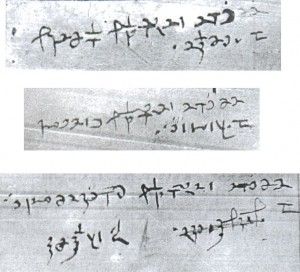Here’s a nice palaeographic puzzle for you! While looking at some images from a linked pair of Florentine astronomical / astrological manuscripts written circa 1400 (as Voynich researchers inevitably do), I noticed that one had an unknown shorthand (?). So far I’ve only had access to a handful of the pages, so the full document would probably contain several more examples – but the three below should be enough to get you going (click to see a higher-resolution image).
Personally, I’m reminded of the Quattrocento astrological shorthand that Robert Brumbaugh described finding on the back of a manuscript of a Plato text (he was, after all, a Plato scholar, though I don’t know which ms that was), which in turn reminded him of the Voynich Manuscript’s lettering.
The text around it is in Latin, relating to individual signs of the zodiac: and a quick examination reveals that many patterns appear in all three of the fragments. But what does it all mean? Any suggestions?

I can’t get to the high-resolution images– also, is deliberately keeping any archive information about it from us part of the game?
Some of it looks like numbers(I see “21” and what could be “3120” in the third fragment), although I’m not sure what to make of that. Maybe this shorthand denotes some technical astrological language, although it doesn’t look much like the usual zodiacal and planetary symbols.
Interesting script there, no idea what it is.
Maybe this isn’t the place to ask, but regarding the Voynich MS, is there a list of folks’ conjectures of the meaning of individual words in the text?
infinitii: sorry about that, I didn’t notice that WordPress’ image handling has changed recently. Link to higher-resolution image now fixed. 🙂
Also: I’m working hard on the rest of the pair of manuscripts for a future blog post, this was just an interesting aside along the way that I thought you would like to see. 🙂
Emily: that’s kind of what I thought, which is why it reminded me so much of what I recall Brumbaugh describing. Brumbaugh can’t have been the only person to note this shorthand before?
Spirochete: people have been coming up with potential “cribs” for decades, though none of them is hugely convincing. For example, in 2000, John Grove tried to attack the “Pleiades” page, but without what I would call success. Herbal cribs are hugely controversial, not only because these are (nearly all) changed beyond recognition, but also because we don’t know the plaintext language, or the dialect, or the local names for plants.
I’ll probably post on this though, it’s a good question, thanks! 🙂
I am from the HASTRO.
The symboll Venus you see in the first one
is actually the first symbol from the left (and not the second one as you wrote).
But it is also found in the other two .
The symbol in which you see the Zenith (written something like scewed greek M and one ‘o’ on a stick) must be the 7th symbol from left on the first patch.
Is this all ?!
Your suggestions are not correct.
These symbols you see cannot be what you suggest.
I would suggest you to tell us the exact number and place (Florence ?) of the manuscript in question.
Otherwise, everything else is devoid of any sense really.
Also I would like to have the whole manuscript in microfilm.
(This does not cost so much. Around 50 euro-cents for a page I guess…)
OK
I am waiting for the number of the manuscript and the exact place of the ‘Latin translation from
Arabic’ in the codex, pages numbers.
rumen kolev
Placidus Research Center for History of Astrology, Varna, Bulgaria
heh heh.
Since I cannot post a picture here, anyone who would like to see the notation on what’s called a ‘Pebble calendar’ is welcome to email me: [email protected]